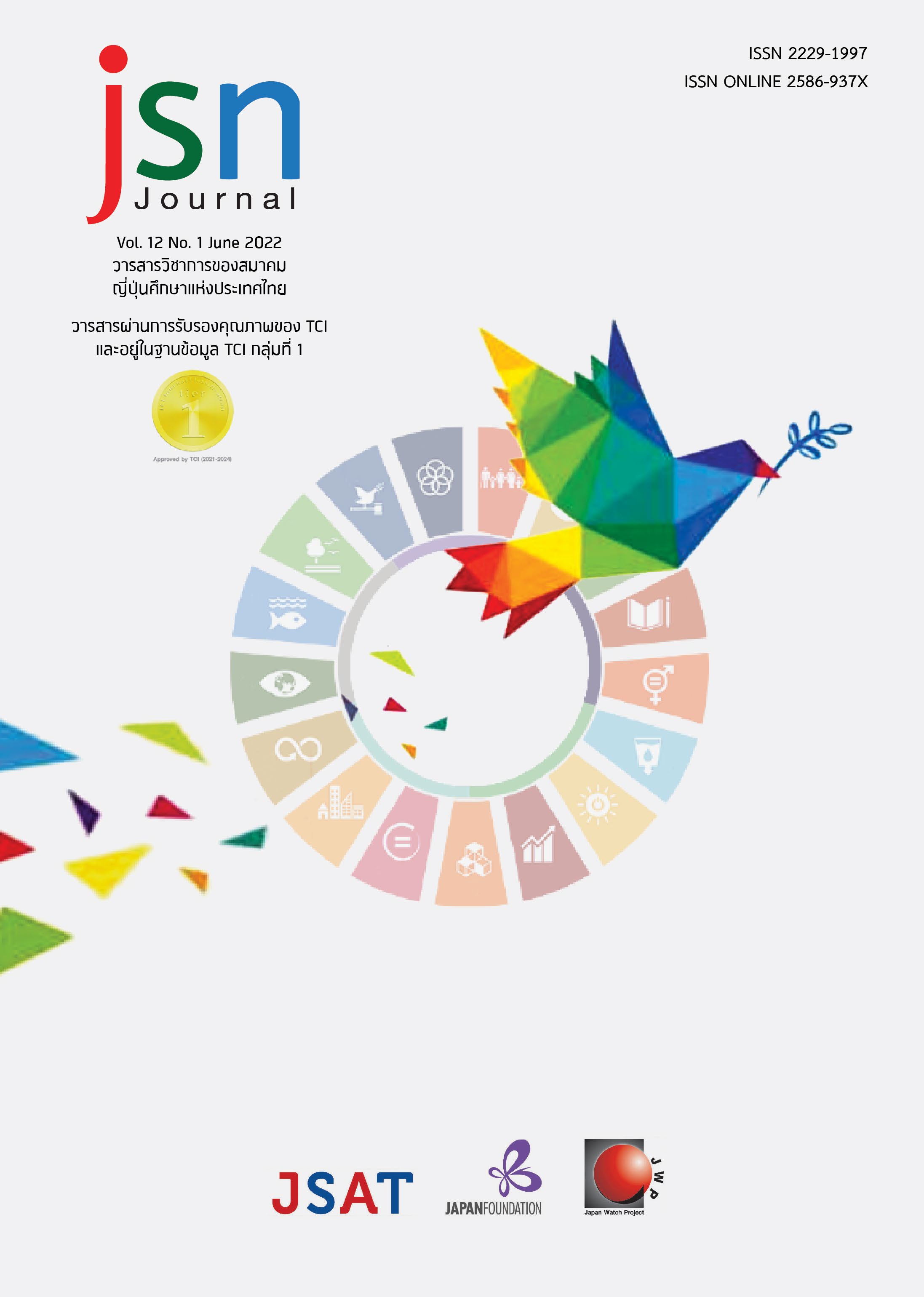Japanese Clustering and Needs of Japanese Toward Long-stay Tourism in Thailand
Main Article Content
Abstract
This research aims to categorize the Japanese clustering that tends to have a long stay in Thailand, to investigate the needs and factors related to the decision-making process of long-stay tourism, and to compare the needs and factors that are related to the categorization of Japanese clustering. The Japanese people aged over 50 years old living in Chonburi province, Rayong province in Thailand and living in Japan were used as samples, with 151 subjects. They tend to visit Thailand with the purpose of having a long stay in Thailand. A total of samples were carried out between August 2018 and February 2019. The research instrument used in this research project is an online questionnaire. Descriptive statistics were used to analyze the data. Clustering analysis and hierarchical clustering were also used for data analysis. The results of the study show that the Japanese clustering was categorized into three groups: Group A, the single Japanese people (counted as 27.15%); Group B, the Japanese men with duties of taking care of their family (counted as 62.25%); and Group C, the Japanese women with duties of taking care of their family (counted as 10.60%). It was found that there were factors which attracted the Japanese people to have a long stay in Thailand. Group A people considered the weather the most important thing. Group B and C people considered the cost of living the most important factor. People in Group A were more likely to live in Thailand than people in Groups B and C. Regarding their needs, it was found that three groups of people needed medical service from public hospitals the most. Concerning accommodation, Group A and B people were expected to live in condominiums, whereas Group C people were expected to live in serviced apartments. The rent was the most important factor for people in Groups A and B when choosing a place to live. Group C people considered cleanliness and tidiness as the most important. All three groups of people considered the city environment the most important thing, and they needed to live near the hospital to reach the hospitals within 15–30 minutes. Regarding additional facilities, it was found that Group A people needed health assurance as the most important thing, while Group B and C people needed an interpreter as the most important thing.
Article Details

This work is licensed under a Creative Commons Attribution-NonCommercial-NoDerivatives 4.0 International License.
ข้อความและข้อคิดเห็นต่างๆ ในบทความเป็นของผู้เขียนบทความนั้นๆ ไม่ใช่ความเห็นของกองบรรณาธิการหรือของวารสาร jsn Journal
References
กมลรัฐ อินทรทัศน์ และคณะ. (2549). ศักยภาพของไทยต่อการดำ เนินการท่องเที่ยวแบบพำ นักระยะยาว. กรุงเทพฯ: สํานักงานเลขาธิการวุฒิสภา.
ณิชาภัทร สุรวัฒนานนท์. (ม.ป.ป.). การท่องเที่ยวกับบทบาทขับเคลื่อนเศรษฐกิจไทย ฮีโร่จำเป็นหรือ ฮีโร่ตัวจริง?. https://www.bot.or.th/Thai/ResearchAndPublications/articles/Pages/Article_29Oct2019.aspx
เบญจรัตน์ มรรยาทอ่อน. (ม.ป.ป.). Visit world campaign-meeting the 2010 challenge. จุลสารวิชาการอิเล็คทรอนิกส์
การท่องเที่ยวแห่งประเทศไทย. http://www.etatjournal.com/upload/260/Visit_World Campagine.pdf
พนิดา อนันตนาคม. (2557, กรกฎาคม-กันยายน). ข้อเสนอยุทธศาสตร์ตลาดลองสเตย์: การศึกษาภูมิหลังทางวัฒนธรรมและการใช้ชีวิตของกลุ่มเป้าหมายให้มากขึ้น. วารสารการท่องเที่ยวแห่งประเทศไทย (3). http://www.etatjournal.com/web/menu-read-web-etatjournal/menu-2014/menu-2014-jul-sep/606-32557-longstay)
มหาวิทยาลัยราชภัฏสวนสุนันทา. (2551). รายงานเรื่องรูปแบบที่พักแบบพำนักระยะยาวที่เหมาะสมสาหรับประเทศไทย. ํ กรุงเทพฯ: สำนักงานพัฒนาการท่องเที่ยว กระทรวงการท่องเที่ยวและกีฬา.
วรางคณา ก่อเกียรติพิทักษ์ และดวงพร ภิญญะพันธ์. (2553). ข้อสังเกตบางประการต่อผลทางเศรษฐกิจและสังคมจากการพำนักระยะยาวของชาวญี่ปุ่นในประเทศไทย. วารสารญี่ปุ่นศึกษา, 26(2), 53-70.
วารัชต์ มัธยมบุรุษ. (2554). ส่วนประสมตลาดการท่องเที่ยวพำนักระยะยาวสำหรับนักท่องเที่ยวชาวญี่ปุ่นที่พำนักระยะยาวในจังหวัดเชียงใหม่. Naresuan University Journal, 2011. Special Issue, 80-88.
วารัชต์ มัธยมบุรุษ. (2556). การตลาดการท่องเที่ยวสำหรับนักท่องเที่ยวชาวญี่ปุ่นที่พำนักระยะยาวในจังหวัดเชียงใหม่. วารสารการบริการและการท่องเที่ยวไทย, 8(2), 48-61.
ศรีสุดา โสภา. (2556). ปัจจัยที่มีอิทธิพลต่อการตัดสินใจของชาวญี่ปุ่นที่มาพำ นักระยะยาว (Long stay) ในจังหวัดเชียงใหม่. คณะเศรษฐศาสตร์ มหาวิทยาลัยเชียงใหม่.
สุดปรารถนา ดวงแก้ว. (2558). การปรับตัวทางสังคมและวัฒนธรรมของคนญี่ปุ่นวัยหลังเกษียณที่พำนักระยะยาวในเชียงใหม่ ประเทศไทย. วารสารญี่ปุ่นศึกษา, 57-75
อรชร มณีสงฆ์ และพัชรา ตันติประภา. (2561, มกราคม-มิถุนายน). ความพึงพอใจต่อบรรยากาศการตลาดกับความตั้งใจในการมาซ้าของผู้มาเยือนแหล่งท่องเที่ยวแบบพ ํ ำนักระยะยาวในจังหวัดเชียงใหม่. วารสารวิชาการการท่องเที่ยวไทยนานาชาติ, 14(1), 59 -76.
Elisa Nishikito. (2020). The Current Situation of Aging Japanese Retirees and Their Impacts on Medical Services in Chiang Mai Province, Thailand. jsn journal, 10 (2), 100-118.
Funck, Carolin and Coope, Malcolm. (2015). Japanese tourism: Spaces, places and structures. New York: Berghahn.
JTB Tourism Research & Consulting Co. (2019). ロングステイ (long stay). Retrieved from https://www.tourism.
jp/tourism-database/glossary/long stay/)
Ono, Mayumi. (2008). Long-stay tourism and international retirement migration: Japanese retirees in Malaysia.
Yamashita et al., eds. Transnational Migration in East Asia Senri Ethnological Reports, 77, 151-162.
Ono, Mayumi. (2010). Long-stay tourism: Elderly Japanese tourists in the Cameron Highlands, Malaysia. Senri Ethnological Studies, 76, 95-110.
一般財団法人ロングステイ財団 (Long Stay Foundation). (2019). ロングステイ財団について.https://www.longstay.
or.jp/about/history/(in Japanese)


